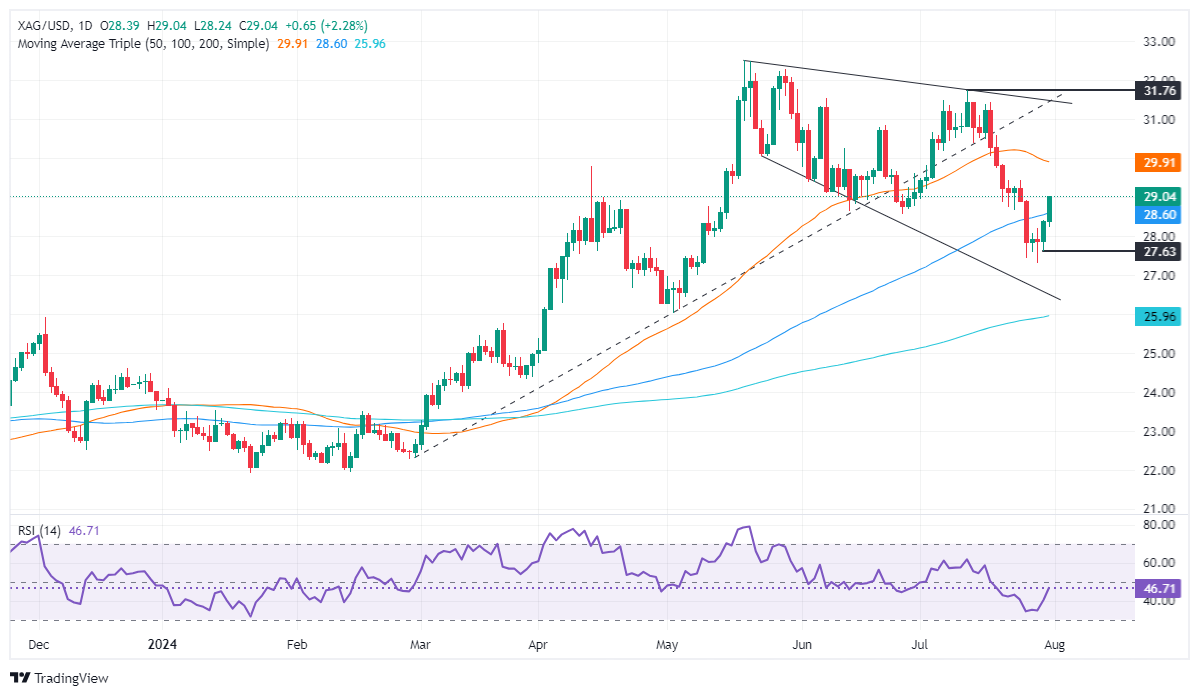Silver Price Analysis: XAG/USD surges over 2% aims towards $29.00
- Silver price jumps over 2%, trading at $28.99 after bouncing from daily lows of $28.25.
- XAG/USD clears the 100-DMA at $28.58; key resistance at $29.00 in focus.
- RSI indicates strengthening bullish momentum; next targets include $29.44 and $30.00, with support at $27.31 if bearish reversal occurs.
Silver price resumed its uptrend and surged over 2% on Wednesday, clearing the 100-day moving average (DMA) at $28.58, a key resistance level that capped the grey’s metal advance toward $29.00. The XAG/USD trades at $28.99 after bouncing off daily lows of $28.25.
XAG/USD Price Analysis: Technical outlook
The grey metal uptrend remains in play, though buyers' lack of strength to achieve a daily close above $29.00 could expose the precious metal to selling pressure.
Buyers gathered some steam as shown by the Relative Strength Index (RSI), which, despite being below the neutral line, the steepest advance, hints that it would turn bullish and confirm price action.
If XAG/USD reclaims $29.00, the next stop would be the July 24 peak of $29.44, followed by the 50-day moving average (DMA) at $29.89. Further gains are seen once Silver tops $30.00. Conversely, if XAG/USD slumps below the 100-DMA at $28.58, the next support would be the July 29 bottom of $27.31, followed by the $27.00 figure.
XAG/USD Price Action – Daily Chart

Silver FAQs
Silver is a precious metal highly traded among investors. It has been historically used as a store of value and a medium of exchange. Although less popular than Gold, traders may turn to Silver to diversify their investment portfolio, for its intrinsic value or as a potential hedge during high-inflation periods. Investors can buy physical Silver, in coins or in bars, or trade it through vehicles such as Exchange Traded Funds, which track its price on international markets.
Silver prices can move due to a wide range of factors. Geopolitical instability or fears of a deep recession can make Silver price escalate due to its safe-haven status, although to a lesser extent than Gold's. As a yieldless asset, Silver tends to rise with lower interest rates. Its moves also depend on how the US Dollar (USD) behaves as the asset is priced in dollars (XAG/USD). A strong Dollar tends to keep the price of Silver at bay, whereas a weaker Dollar is likely to propel prices up. Other factors such as investment demand, mining supply – Silver is much more abundant than Gold – and recycling rates can also affect prices.
Silver is widely used in industry, particularly in sectors such as electronics or solar energy, as it has one of the highest electric conductivity of all metals – more than Copper and Gold. A surge in demand can increase prices, while a decline tends to lower them. Dynamics in the US, Chinese and Indian economies can also contribute to price swings: for the US and particularly China, their big industrial sectors use Silver in various processes; in India, consumers’ demand for the precious metal for jewellery also plays a key role in setting prices.
Silver prices tend to follow Gold's moves. When Gold prices rise, Silver typically follows suit, as their status as safe-haven assets is similar. The Gold/Silver ratio, which shows the number of ounces of Silver needed to equal the value of one ounce of Gold, may help to determine the relative valuation between both metals. Some investors may consider a high ratio as an indicator that Silver is undervalued, or Gold is overvalued. On the contrary, a low ratio might suggest that Gold is undervalued relative to Silver.